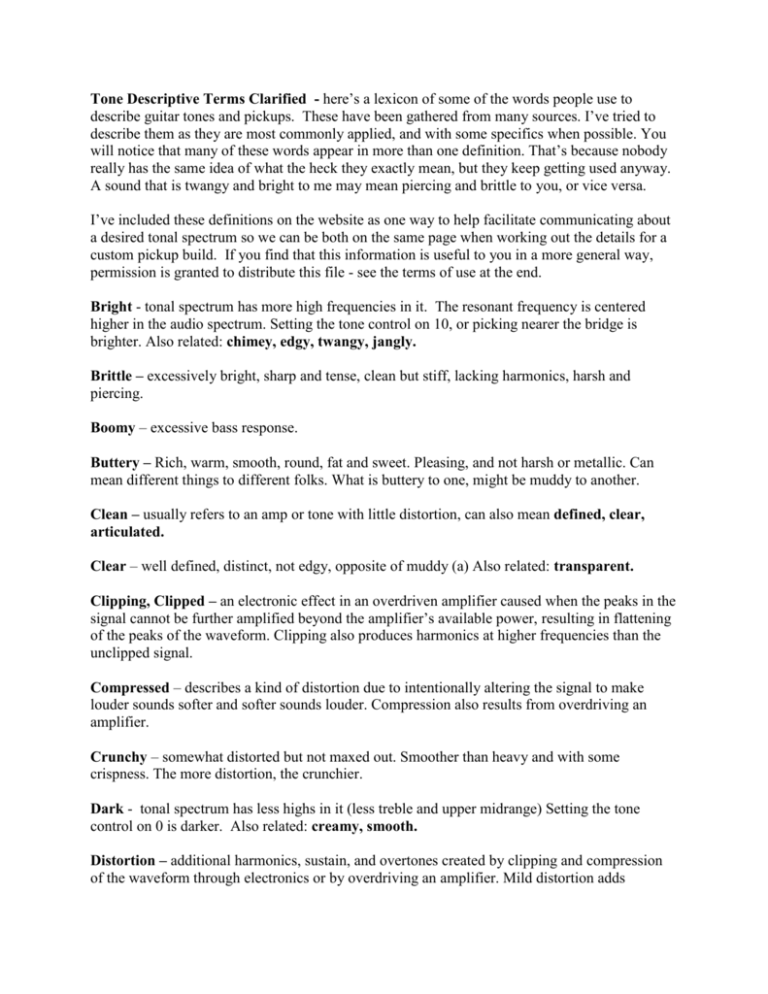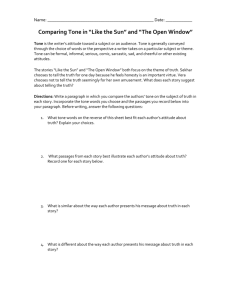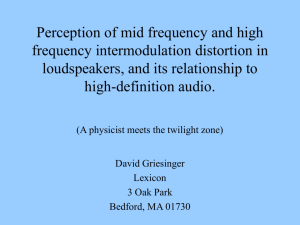
Tone Descriptive Terms Clarified - here’s a lexicon of some of the words people use to
describe guitar tones and pickups. These have been gathered from many sources. I’ve tried to
describe them as they are most commonly applied, and with some specifics when possible. You
will notice that many of these words appear in more than one definition. That’s because nobody
really has the same idea of what the heck they exactly mean, but they keep getting used anyway.
A sound that is twangy and bright to me may mean piercing and brittle to you, or vice versa.
I’ve included these definitions on the website as one way to help facilitate communicating about
a desired tonal spectrum so we can be both on the same page when working out the details for a
custom pickup build. If you find that this information is useful to you in a more general way,
permission is granted to distribute this file - see the terms of use at the end.
Bright - tonal spectrum has more high frequencies in it. The resonant frequency is centered
higher in the audio spectrum. Setting the tone control on 10, or picking nearer the bridge is
brighter. Also related: chimey, edgy, twangy, jangly.
Brittle – excessively bright, sharp and tense, clean but stiff, lacking harmonics, harsh and
piercing.
Boomy – excessive bass response.
Buttery – Rich, warm, smooth, round, fat and sweet. Pleasing, and not harsh or metallic. Can
mean different things to different folks. What is buttery to one, might be muddy to another.
Clean – usually refers to an amp or tone with little distortion, can also mean defined, clear,
articulated.
Clear – well defined, distinct, not edgy, opposite of muddy (a) Also related: transparent.
Clipping, Clipped – an electronic effect in an overdriven amplifier caused when the peaks in the
signal cannot be further amplified beyond the amplifier’s available power, resulting in flattening
of the peaks of the waveform. Clipping also produces harmonics at higher frequencies than the
unclipped signal.
Compressed – describes a kind of distortion due to intentionally altering the signal to make
louder sounds softer and softer sounds louder. Compression also results from overdriving an
amplifier.
Crunchy – somewhat distorted but not maxed out. Smoother than heavy and with some
crispness. The more distortion, the crunchier.
Dark - tonal spectrum has less highs in it (less treble and upper midrange) Setting the tone
control on 0 is darker. Also related: creamy, smooth.
Distortion – additional harmonics, sustain, and overtones created by clipping and compression
of the waveform through electronics or by overdriving an amplifier. Mild distortion adds
richness and thickness to the sound. More extreme distortion can be described as heavy, gritty
and harsh.
Dirty – with gain and distortion, rough, raw, and somewhat noisy. Opposite of clean.
Edgy – having more or too much high frequencies. Distorted with harmonics that add raspiness,
the opposite of mellow. Also related: steely, harsh.
Fat, Thick - resonant peak is broader and centered lower in the frequency spectrum. Also
related: full, warm, creamy, beefy.
Full – Strong fundamentals relative to harmonics, opposite of thin.
Glassy – sharp, clear but grainy, ringing, reminiscent of a cymbal. Usually refers to a single coil
sound. Hard to pin down, but in searching for a definition of this the names John Frusciante and
Jimi Hendrix (on Little Wing) come up a lot, as well as the Fender Twin Reverb amp and
sometimes Stevie Ray Vaughan.
“Greeny” Peter Green Tone – This is a clean, cutting, shivering, out-of-phase tone achieved by
Peter Green in his Bluesbreakers and early Fleetwood Mac days on a 59 Les Paul that had the
neck pickup rewound in reverse. The guitar was owned for a long time by Gary Moore who used
it in the album “Blues for Greeny”. Flipping a magnet in a humbucker will give part of the
effect, but is not all there is to it.
Gritty – dirty, somewhat clipped and distorted with emphasized odd order harmonics, a little
biting, raspy, noisy, similar to mildly crunchy.
Grungy – lots of harmonic distortion.
Hard – too much upper midrange. Also related: harsh, honky, strident.
Heavy – thick, massive, forceful, and excessively loud, with much distortion. Also related:
metal, thrash.
Honk – having a saxophone like sound character (as in some Strat pickups, a few Les Pauls) not
quite the same as honky (as in hard or harsh). Also related: quack.
Hot - having relatively more output (than a pickup that is “normal, or not hot”)
Huge – a unique tonal quality mainly found only in descriptions of guitars that are offered on
sale for a limited time, and on auction sites. Always followed by the words tone or sound. The
more exclamation points after the word tone, the huge-er it sounds. Also related: killer,
fantastic, perfect, (just about any word will do, with enough !!!!’s, since it doesn’t really
describe anything meaningful.)
Icy – very bright and piercing, ringing, slightly echoing, and sustained. Not brittle or screeching.
Best defined by the music of Albert Collins, who was famous for icy tones achieved with a very
percussive finger style attack, open minor tuning, and a capo on the 5th fret. (being born a cousin
to Sam Lightnin’ Hopkins and Willow Young didn’t hurt a whole lot either.)
Mellow – reduced upper mid-range – opposite of edgy. Also related: gentle.
Metal – loud, heavy, forceful, distorted, with emphasized bass and often with reduced (scooped)
middle frequencies.
Muddy (a)– lacks definition, not clear, weak harmonics. Also related: smeared, indistinct.
Muddy ( b- refers to highs) – upper frequencies filtered out. Also related: muffled.
Overdriven – see clipped and compressed. A smooth overdriven but not excessively distorted
tone is richer, fuller, and more sustaining than a clean tone.
Organic – natural, feral, untainted, stuff like that. Who knows... probably means woody if
anything.
Out-of-PhaseTone - a distinct, instantly recognizable, hollow, trebly, very bluesy, almost
harmonica-like tone. Achieved by combining two pickups that are wired out of phase with each
other. Seems to be caused mainly by having megatons of natural talent. Some of the more
famous players to exploit this kind of tone are: BB King, T-Bone Walker, and Peter Green.
Piercing – excessive highs, screechy, strident, hard on the ears. Also related: icy, cutting,
brittle, stinging.
Punchy – having good reproduction of dynamics.
Rich - full with even-order harmonics.
Round – clear with high frequencies rolled off. Not edgy.
Scorching – heavily overdriven but with definition and sustain. Between crunchy and heavy.
Screeching - beyond piercing or stinging, excessive highs to the point of painfulness.
Smooth – balanced not harsh or edgy, like round, creamy, sweet, juicy, etc.
Stinging – bright but not piercing.
Strident – harsh, edgy, aggressive.
Sustaining – notes continue to ring longer than usual. After the initial attack, notes decay to the
sustaining level before again decaying to zero.
Sweet – not strident or piercing, clear with low distortion.
Thin – fundamentals are weak relative to harmonics.
Tight - can mean anything. Usually means good low frequency response. Might be a bass
response that is deep but not too boomy.
Tinny – reminiscent of a telephone or tin can, muffled lows with high frequencies emphasized.
Twang – bright, sharp, almost chimey sound (characteristic of a Telecaster or Gretsch).
Warm – having a more balanced sound spectrum. Broad and centered resonant peak. Good bass
and not thin. (Not used to describe output levels) Also related: juicy, creamy, round, sweet,
buttery.
Vintage – a tonal quality reminiscent of the collective imagination of what yesterdays’ 45 rpm
recordings might have sounded like if you had heard them live instead of over the radio. (Just
kidding, but it isn’t that far off either.) Also used as the opposite of “hot”, “modern”, or
“distortion” when comparing humbucker pickup styles.
Woody – can mean many things. Mainly it’s an electric tone that sounds a tiny bit dirty but very
natural, not muddy at all, and a little hollow like a loud acoustic. Picking in the middle of the
neck over the frets is woodier than picking near the bridge. Also related: organic.
Woman Tone – not characteristic of any pickup or guitar by itself. Specifically refers to a tone
associated with Eric Clapton and Cream. Articulated but overdriven and thick, distorted and
muted. Achieved using the neck pickup of an SG guitar with the tone control all the way down,
and all the Marshall amp controls all the way up, but has much to do with his technique, and
maybe a wah pedal.
.....
Giving credit where it is due, many of these definitions were adapted from an audiophile’s
glossary obtained here: http://www.faqs.org/faqs/AudioFAQ/part2/ and Wikipedia entries. The
rest were just made up with a little help from my friends Al K. Hall and Nick O’Teen, who also
dropped in random contributions in several other sections as well.
-----------Return to home page
© Copyright 2011, Sonny Walton
All rights reserved.
Terms of Use:
This pdf file can be downloaded and used for any noncommercial purpose as long as the reference to
http://sonnywalton.com/Home_Page.php , all credits are included and copyright notice is retained.







